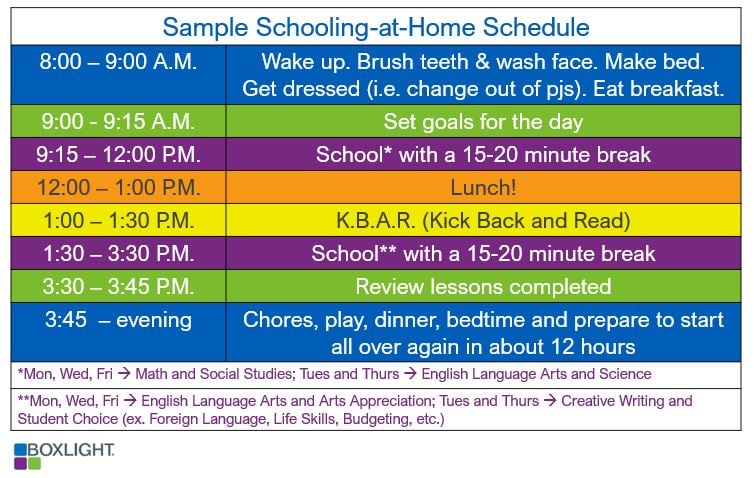
I am a work-from-home mom with a daughter who participates in “alternative” learning (her curriculum comes from an online school). Being locked in with my kid for days on end isn’t new, yet after a number of years, it still has its ups and downs. Even with my experience as a public school teacher, instructional coordinator, and tutor, nothing can really prepare you for having YOUR OWN KIDS at home needing you to help them navigate through this new reality.
From the start, I’ve encouraged my daughter to stick to a routine, reminding her that the routine she follows will carry her through her first job and future career (at fourth grade, she really didn’t care about this line of reasoning as she does now…just so you know). A few things we did you might find helpful:
Follow a Schedule
I created a daily schedule that she could follow from wake-up to bedtime. I color-coded it so she knew which subjects she would focus on each day and for how long. I included her in creating the schedule because she knew which subjects were easier (Language Arts, Art) and which were more challenging (Math, Social Studies). We alternated subjects so that she had something different to focus on each day. The schedule included short breaks and a one-hour lunch where she could do a craft, play on her keyboard, paint, whatever she chose to do. Her schedule looked something like this:

The schedule was posted next to her desk, on the fridge, and next to my desk because it was not only for her, but also for me. I needed her to be as independent as possible since I worked from home. I couldn’t lead her through lessons, so I was thankful for the online program she was enrolled in.*
There are going to be (many, many) moments that your children won’t understand a lesson. Do what you can to give help and/or find a resource online, and believe me, there are TONS of resources online! The challenge is sorting through the overabundance to find applicable materials that they can work through on their own. I generally printed worksheets but my daughter tended to favor free videos and interactive activities. See what works for you and your children. It may take a bit of time, but that’s fine. You’ll hit a “sweet spot” soon enough.
Set Goals
To start the day, we give one another a hug and greeting (this is still my favorite part of the day). This sets up a positive tone, and certainly will be the memory I want to hang on to when we get frustrated, annoyed, irritated, or there’s no more coffee. Our children are adjusting to a new “normal” so easing them in with a simple act of comfort – hug, words, elbow bump – can go a long way. Then, dig in by reviewing the goals for the day, snack and lunch options (VERY IMPORTANT), and the progress you expect to hear by the end of the day. You can also answer questions (Can I watch a movie at lunch? Can I go on Instagram at my break? Do I HAVE to do math today?) and clear up any issues at the start.
This can also be a good time to bring up challenges from the day before that need to be worked out. For example, there were days that the online program glitched and my daughter could not access her lessons. Was an email sent? Did the issues get resolved? How much needs to be made up or can be excused? If the glitch is still ongoing, what is an alternative? (Because I was a tutor, I had a treasure trove of workbooks at home and printable worksheets are easy to find online)
If you are responsible for the curriculum, start with a group minilesson/discussion that focuses on a current event. Keep it relevant, accessible for all of the ages in your family, and include some type of kinesthetic/visual. For example, share this popular and timely video on the importance of handwashing: Washing Hands and Pepper Experiment. Then take a few minutes to do this experiment and talk about what happened and why. These types of discussions really help you understand how your children are taking in what’s happening around them and what else you can do to support (comfort) them. Some other fun ideas to address what’s going on (and why it’s keeping them at home vs school):
- washyourlyrics.com Write some original handwashing songs, print them out, and post them
- Facts About Coronavirus Great article on COVID-19 on National Geographic Kids; read the article together or skim key information and have older children read on their own and bring in to discussion the following morning
- Coronavirus Explained!, Explaining the Coronavirus to Your Kids (this has a cool way of explaining coronavirus with a balloon in the beginning), or choose a video that you think is appropriate
- Just For Kids: A Comic Exploring the New Coronavirus This is a great way to involve your children in making their own comics that connects with them and their peer group (share the comics with other families)
Be Ready to Adapt!
This is new. Online programs glitch. School work runs out. Kids ask questions … lots and lots of questions. If you’re working from home (now or have been), the added “bonus” of your children at home with you all day can be a little unnerving. You’re used to a routine and expect that everyone around you will respect that routine (and your peace). Nope.
Especially in the beginning, interruptions (distractions) are numerous as everyone is trying to adjust. That’s a large reason why the “Set Goals” part of the day is important – minimize questions (What do we do now? I’m done with my work, what can I do now?) and stress as much focus as possible during “School.” Try to have a list of activities that your children can do after they’ve completed their assignments like creative writing, drawing, reading, or stretching/floor exercises. If they’re not interested in those choices, offer chores. You will probably find that they would rather silently read a book versus cleaning the toilet.
That being said, there will still be distractions. There will be times where you will need to address little “fires” (i.e. issues with a program, question about how to solve a problem, reminders about snacks, etc.). Your children should understand that these dedicated blocks of time are quiet(er) times so that everyone can focus on the tasks each is responsible for. Stress that you also have responsibilities – “Work” – and you have goals for the day. It’s a good idea to even tell your children that you will get to them in a bit, finish what you need to do, then attend to their need.
Flexibility Can Be Fun
Some flexibility may be called for as everyone gets used to the routine of staying home. There will be moments of frustration because your children can’t see their friends as often (or at all, depending on the level of self-quarantine), your own schedule has to be modified, and not being able to separate school from home is a difficult adjustment. When these moments occur, take an unscheduled BREAK. If you have a yard, go outside and play – have a real recess! Play an instrument for some music appreciation. Dance to one of your Spotify playlists. Introduce some Home Ec. skills and show them how to create a grocery list with a budget or sort the laundry and explain why that’s necessary (one of my faves). We all need a restart from time to time, and you may find that a quick one can make all the difference.
Free Resources Online
Take advantage of the free resources available online. Your children’s district or school may not have offered an online program (things really happened quickly before schools were closed so this is more common than not) and instead sent home work packets with teacher communication available via email, phone calls/text messages, or video calls. For those times when assignments are completed or they start to get restless or you just need some quiet time, here are a few suggestions:
- Epic! is a digital library for children 12 and under. You can join for free for 30 days, so take advantage of that! Library closed? No problem!
- NASA has an abundance of online activities, games, and e-books. The galleries alone are worth exploring this website.
- PBSKids has games, videos, and other resources that are perfect for our young ones. They also have a daily activities and tips newsletter you can sign up for.
- Duolingo helps your children learn a new language with through games and a rewards system.
- Circletime are on-demand lessons for children 0 – 6. Watch videos and follow along with an instructor that leads lessons on cooking, colors, and even singing!
- National Geographic Kids is a personal favorite because there are so many things to explore, from articles and books to games and videos.
You can also search for free art, music, coding, cooking, dance, etc. types of lessons on YouTube. When my daughter was younger, I searched beginner piano lessons and she learned on her keyboard (her music block). Of course, invest the time and do the search yourself and bookmark any videos/channels you think your children will enjoy. Stick to those until you deem otherwise.
It’ll Work Out
This is new territory for many of us and it can feel overwhelming … for everyone. Be patient with your children and especially yourself. We’re all learning how to do this, while keeping calm and cool heads during a surreal time in our history. After 7+ years, I’m still learning. But the best part is that I have a great relationship with my daughter, I’ve seen her grow and have learned so much about her personality. Look forward to that positive.
*If your children are participating in an online learning program provided by the school, most programs expect one hour of work in each subject per day. Hopefully your children’s school has given you information about what the expectations are and if assignments can be completed by the end of the week versus end of the day. This allows for more flexibility, especially since this is a new experience for everyone involved.


